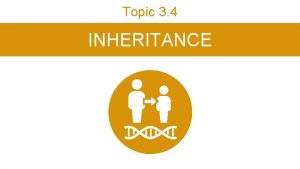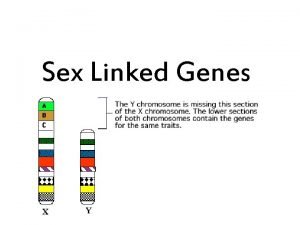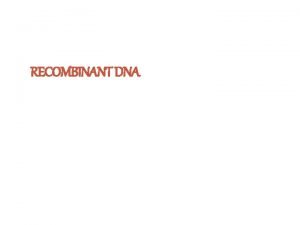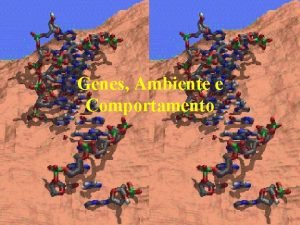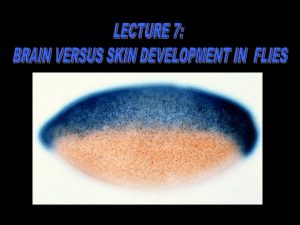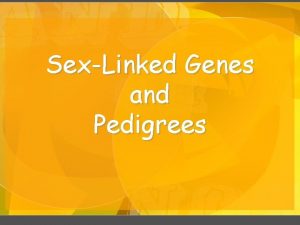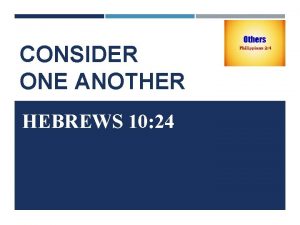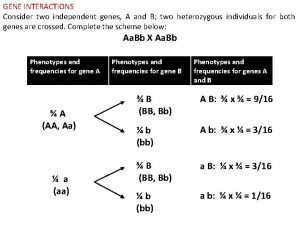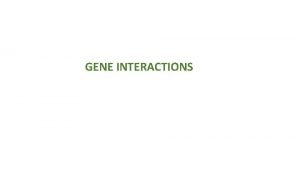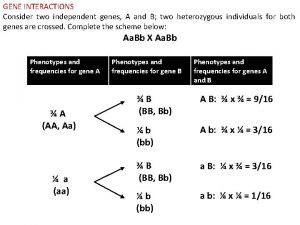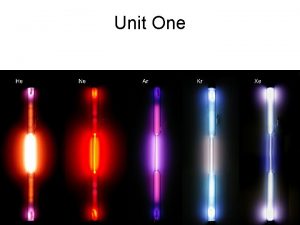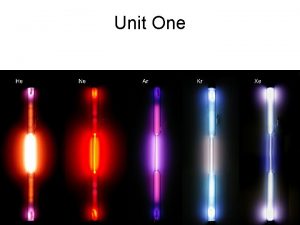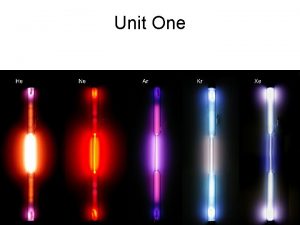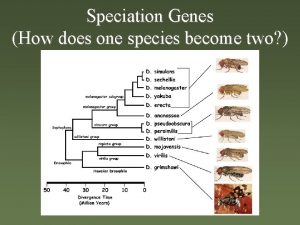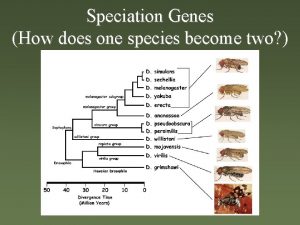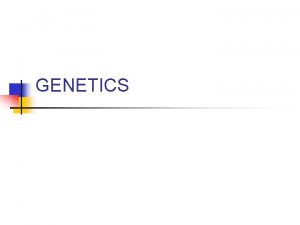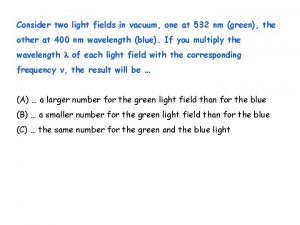What if we consider two genes at one






















- Slides: 22

What if we consider two genes at one time? • Mendel’s law of independent assortment. • What happens with one gene has no effect on the other.


Outcome • • • 9/16 Smooth, Yellow 3/16 Wrinkled, Yellow 3/16 Smooth, Green 1/16 Wrinkled, Green Combining these, you’ll find that – 9/16 + 3/16 = 12/16 = 3/4 are smooth, 1/4 wrinkled – 9/16 + 3/16 = 12/16 = 3/4 are yellow, 1/4 green

Law of independent assortment • Each gene assorts independently, not affected by other genes. • This occurs if each gene is on a different chromosome. • Story is different if 2 genes are on the same chromosome (linkage) but we won’t discuss that in detail.


Dihybrid cross • Aa. Bb x Aa. Bb phenotypic ratios 9: 3: 3: 1 9/16 dominant phenotype for both traits (A-B-) 3/16 are A-bb 3/16 are aa. B 1/16 are aabb (recessive for both traits) • Consider outcome of other crosses.

2 -gene crosses: multiplying probabilities instead of punnett square • Problem: Aa. Bb x Aabb • Consider outcome of each gene separately: Aa x Aa = ¾ A- and ¼ aa Bb x bb = ½ Bb and ½ bb • Fraction of offspring with each phenotypic combination can be derived by multiplying A-Bb = (3/4) (1/2) = 3/8 A-bb = (3/4) (1/2) = 3/8 aa. Bb = (1/4) (1/2) = 1/8 aabb = ((1/4) (1/2) = 1/8

Extensions to Mendelian genetics • • • Multiple alleles Incomplete dominance Polygenic inheritance Pleiotropy Linkage Sex-linkage

Multiple alleles • Across the whole population, there may be many more than just two alleles of a given gene. • (Each diploid individual has at most two alleles, if they are heterozygous. ) • For example, there are 4 alleles for fur color in rabbits. Particular color of a rabbit depends on which allele it possesses. (See fig. 10. 12 but don’t sweat the details unless you want to. )

Incomplete dominance • Up till now, the heterozygote always looked just like one homozygote, but that’s not always the case. • Sometimes the heterozygote is intermediate between the two homozygotes. • However, this is not blending inheritance. The alleles remain distinct and will segregate in the next generation.


Human ABO Blood Groups: an example of both multiple alleles and codominance (a kind of incomplete dominance) • There are four phenotypes: A, B, AB, and O • These are controlled by three alleles: IA, IB, and IO (Io is often written as “i” because it is recessive) • Genotypes responsible for the phenotypes: – IAIA and IAIO both have Type-A blood – IBIB and IBIO both have Type-B blood – IAIB has Type-AB blood (codominance) – IOIO has Type-O blood (homozygous recessive)


ABO Transfusion Compatibility • Both the IA and IB alleles put a protein on the rbc’s that is recognized by the immune system. • The immune system of a Type-A person will attack any rbc’s with B protein (cannot accept B or AB blood). • The immune system of a Type-B person will attack any rbc’s with A protein (cannot accept A or AB blood). • A type-AB person will accept both A and B proteins. • The IO allele does not put any protein on the rbc’s, therefore, type O blood is accepted by anyone. • The immune system of a Type-O person will attack any rbc’s with either A or B protein (can only accept type O).

ABO blood group compatibility Blood group Can donate to: Can receive from: A A or AB A or O B B or AB B or O AB AB only A, B, AB, or O O only (universal recipient) O (universal donor)

Polygenic inheritance • Sometimes many separate genes control the same characteristic. • Each gene may have two or more alleles. • The effects of the genes are often additive: each adds a little to the character in question. • This explains continuous variation in characters like height, weight, etc.


Continuous variation • Continuous characters like height and weight are also affected by the environment (e. g. nutrition during development). • Thus, there are no apparent categories in the offspring. • Another reason that Mendel’s work was ignored at first was that everyone thought that continuous characters were more important than 2 -state characters, but couldn’t see how Mendelian genetics explained them. Polygenic inheritance was not worked out until the 1920’s.

Pleiotropy • One gene may affect unrelated characters. • Gene for coat color in Siamese cats also causes crossed eyes. • Gene that causes sickle-cell anemia (when homozygous) also confers resistance to malaria (when heterozygous).

Sex determination • A variety of mechanisms exist in various species. Many (not all) involve sex chromosomes. • In humans, one pair of chromosomes determines sex. • Individuals with two X chromosomes are female. • Individuals with an X and a Y are male. • The Y chromosome is very small and carries few genes other than those that code for maleness. • The X chromosome is large, and carries many genes that have nothing to do with gender.

Sex-linked inheritance • Applies to genes located on the X chromosome. • Examples include color-blindness, male pattern baldness, and hemophilia. • These traits are recessive, but in males they are always expressed, since the male has only one X. • Sons cannot inherit these from their fathers, because they get a Y, not an X, from dad.

Sex-linked genetics problems • What happens if a normal man marries a normal woman whose father was color-blind. • C = normal vision, c=color-blindness • Dad is CY. Mom is Cc. • Half of their daughters are CC; half are Cc. All have normal vision. • Half of their sons are CY (normal); half are c. Y (color-blind)
 Linked genes and unlinked genes
Linked genes and unlinked genes Genepattern
Genepattern Polygenic inheritance
Polygenic inheritance Willow cabin speech
Willow cabin speech Consider two edge dislocations of opposite sign
Consider two edge dislocations of opposite sign Model apt
Model apt Consider a case of a two-component standby system
Consider a case of a two-component standby system Show that the maximum efficiency of pure aloha is 1/(2e)
Show that the maximum efficiency of pure aloha is 1/(2e) One empire one god one emperor
One empire one god one emperor Little dog run
Little dog run One king one law one faith
One king one law one faith One god one empire one emperor
One god one empire one emperor One ford
One ford See one do one teach one
See one do one teach one See one, do one, teach one
See one, do one, teach one See one do one teach one
See one do one teach one One vision one identity one community
One vision one identity one community Asean one vision one identity one community
Asean one vision one identity one community Two mothers one on one
Two mothers one on one Alleles are
Alleles are Sex-linked traits examples
Sex-linked traits examples Stabilizing selection human birth weight
Stabilizing selection human birth weight Complementary genes example
Complementary genes example



















